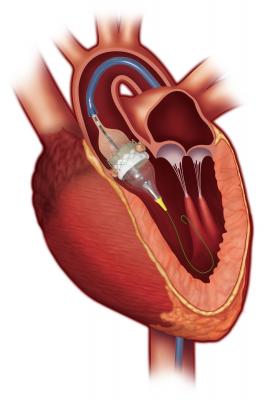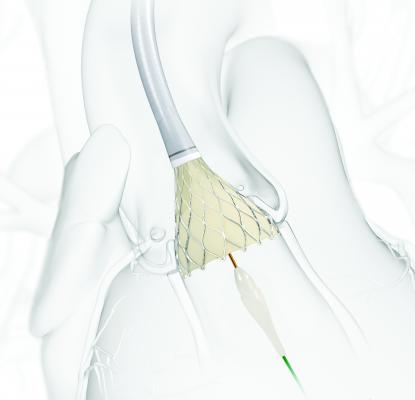
January 15, 2016 — The U.S. Food and Drug Administration (FDA) has given its approval for an expanded indication study of Edwards' Sapien 3 valve in low-risk patients. This will be the first U.S. study of a transcatheter aortic valve replacement (TAVR) device in this patient population, which would normally receive an open-heart surgical valve replacement. If TAVR proves to be at least equal in outcomes to surgery, it will likely cause a paradigm shift in the standard of care.
Patients enrolled in the new PARTNER III Trial will be randomized to receive either the Sapien 3 TAVR or surgical aortic valve replacement (SAVR). The investigational device exemption (IDE) study will enroll elderly patients with severe, symptomatic aortic stenosis (AS) who have been determined by a heart team to be at low risk for mortality if they were to undergo SAVR.
To be eligible for the trial, patients must be at least 65 years old, exhibit symptoms of severe AS and be determined by a heart team to have a surgical risk score of less than 4 percent per the Society of Thoracic Surgeons (STS) adult cardiac surgery risk calculator. The trial is a non-inferiority study with a one-year composite endpoint that includes death, stroke and rehospitalization. Enrollment of approximately 1,300 patients at up to 50 sites is expected to begin during the second quarter of 2016. The trial also includes a 400-patient sub-study using advanced imaging to evaluate leaflet motion in tissue heart valves.
Changing the Standard of Care
For decades, SAVR has been the standard treatment for severe aortic stenosis, but TAVR has rapidly replaced SAVR in high-risk patients the past few years due to excellent clinical trial results showing equal or better patient outcomes compared to SAVR. Today, TAVR is the first-line therapy for inoperable patients with severe AS and an alternative to SAVR in operable high-risk patients.
Watch a video interview with Michael Reardon, M.D., about TAVR having better outcomes than SAVR in the CoreValve pivotal trial. Reardon was the chairman of the patient screening committee for the CoreValve U.S. pivotal trial.
With the value of TAVR proven in extreme- and high-risk patients, the focus of ongoing trials is to gain additional FDA indications in less-sick, intermediate-risk patients. The SURTAVI Trial is examining the use of the CoreValve versus SAVR, and the PARTNER IIA Trial using the Sapien versus SAVR in intermediate-risk patients. Both trials are recruiting patients and are widely expected to show positive results for TAVR.
Evidence from one recent study in Europe suggests TAVR has comparable outcomes in intermediate patients. Between November 2006 and January 2010, 3,666 consecutive patients underwent either TAVI (n = 782) or SAVR (n = 2,884), and researchers matched patients with STS scores for intermediate-risk patients between the two groups. They found cumulative all-cause mortality at 30 days and one year was similar among propensity score-matched TAVI and SAVR patients at intermediate surgical risk.[1]
Newer Valves
There were some issues with the first-generation TAVR devices, including larger sizes requiring alternative access to the preferred femoral artery and vascular complications. To justify treating younger, healthier patients who do very well with SAVR, TAVR needs to show it can lower complication rates to be equal to SAVR in this population.
However, second-generation TAVR devices approved by the FDA in 2015 address many of those limitations. The current-generation TAVR systems are the balloon-expandable Edwards Sapien 3, and the recapturable, self-expanding Medtronic CoreValve Evolut R System. Both systems have been revised to reduce paravalvular leak and make them easier to deliver, including a smaller vascular entry diameter, making them more compatible with femoral access. These newer devices are still limited to the treatment of extreme and high-risk patients suffering from severe, symptomatic AS.
Watch a video interview with Juan Granada, M.D., on the development of new TAVR technology to address performance issues. Granada is the executive director and chief scientific officer of the Cardiovascular Research Foundation's Skirball Center for Innovation.
References:
1. Piazza N, Kalesan B, van Mieghem N, et al. “A 3-center comparison of 1-year mortality outcomes between transcatheter aortic valve implantation and surgical aortic valve replacement on the basis of propensity score matching among intermediate-risk surgical patients.” JACC Cardiovasc Interv. 2013 May;6(5):443-51. doi: 10.1016/j.jcin.2013.01.136.
2. Haussig S, Linke A. “Patient selection for TAVI 2015 - TAVI in low-risk patients: fact or fiction?” EuroIntervention. 2015 Sep;11 Suppl W:W86-91. doi: 10.4244/EIJV11SWA27.
SURTAVI



 December 20, 2023
December 20, 2023 








